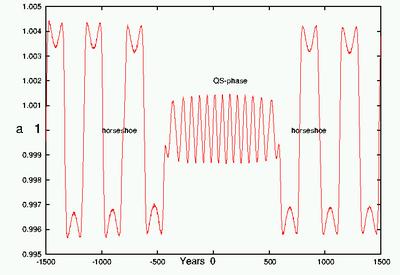

An international team of astronomers, led by Seppo Mikkola of Tuorla Observatory, have made an in depth analysis of so-called quasi-satellites in the solar system. There is only a handful of asteroids in the Solar System, which have the very special property that make them quasi-satellites.
When an asteroid moves on an orbit similar to a planet — going around the Sun in almost exactly the same time — a special situation can result, which makes it look like the asteroid is circling the planet, as a satellite does. Despite the fact that anyone living on the planet would see the asteroid circling around the sky on a regular basis, the asteroid can nevertheless actually be in orbit around the Sun, and not around the planet at all. True satellites circle the planet, as the Moon does the Earth; quasi-satellites appear to circle the planet from the planet's viewpoint, but are actually circling the Sun.
Quasi-satellites can appear to circle their host planet for very long times — or they can come and go, sometimes lasting for hundreds or even thousands of years before moving back onto much more typical orbits. The new study by Seppo Mikkola and his colleagues in Canada: Kim Innanen (York University), Paul Wiegert (University of Western Ontario), Martin Connors (Athabasca University) and Ramon Brasser (Queens University and CITA) shows under what conditions quasi-satellite orbits can form and how long they last, as well as specifying improved criteria for how to recognise this type of orbit. The first quasi-satellite was only discovered a few years ago, and only four are known in the solar system — one associated with Venus, two with the Earth and one with Mars.
The researchers have found that the angle between the orbit of the planet and the orbit of the asteroid as they circle the Sun plays an important role in the formation and lifetime of quasi-satellites. If the orbits are in the exact same plane, the lifetimes can be very long; if the orbits are sufficiently inclined to each other, the asteroid will become a short-term quasi-satellite for the planet from time to time.
The research has been published in the Monthly Notices of the Royal Astronomical Society (MNRAS, 369, 15).

The figure shows the mean distance to the Sun of the asteroid 2004 GU9 as a function of time, as it circles the Sun. The asteroid is on an orbit, which is very similar to the one taken by the Earth around the Sun, occasionally leading to the special situation that it can appear to circle the Earth, in the same manner as a satellite does (but taking a year to do so). For a period of about 400 years, the asteroid has been on such a quasi-satellite orbit, and will remain so for about 500 more (marked 'QS-phase' in the figure), before returning to a much more typical orbit for asteroids of this type (marked 'horseshoe' in the figure).